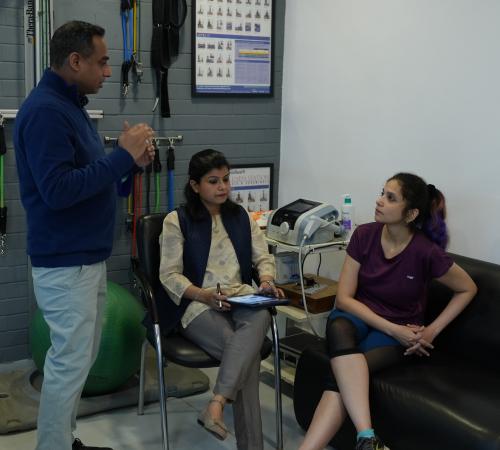Unlocking Your Potential: Understanding Maximum VO₂ and Its Importance for Fitness

When it comes to measuring fitness performance, maximum VO₂—also known as VO₂ Max—is one of the most crucial indicators. Whether you’re a professional athlete, a recreational runner, or simply someone committed to improving health, knowing and improving your maximum VO₂ can significantly boost your endurance, stamina, and overall performance. This metric not only tells you about your current cardiovascular fitness but also guides you in creating targeted training plans for better results.
In this blog, we’ll break down what maximum VO₂ means, why it matters, and how testing it can help you reach your peak potential.
What Is Maximum VO₂?
Maximum VO₂ refers to the maximum amount of oxygen your body can utilize during intense physical activity. It’s measured in milliliters of oxygen per kilogram of body weight per minute (ml/kg/min). In simple terms, it shows how efficiently your body can take in, transport, and use oxygen while exercising.
The higher your maximum VO₂, the better your aerobic fitness. Elite athletes tend to have very high maximum VO₂ scores, allowing them to sustain high levels of activity for longer periods. For everyday fitness enthusiasts, improving maximum VO₂ can mean better energy, improved endurance, and enhanced workout performance.
Why Is Maximum VO₂ Important?
Your maximum VO₂ is more than just a number—it’s a window into your cardiovascular and respiratory health. Here’s why it matters:
-
Performance Indicator – It tells you how much oxygen your muscles can get during intense activity, which directly impacts endurance.
-
Training Effectiveness – Knowing your maximum VO₂ helps in tailoring training plans for optimal results.
-
Progress Tracking – By retesting periodically, you can see if your workouts are truly improving your fitness.
-
Health Assessment – Low maximum VO₂ levels may indicate potential cardiovascular or respiratory limitations.
Factors That Influence Maximum VO₂
Several elements determine your maximum VO₂, including:
-
Genetics – Your natural physiology plays a big role in determining your base oxygen capacity.
-
Training – Regular aerobic training can significantly improve your maximum VO₂.
-
Age – VO₂ levels typically peak in your 20s and gradually decline with age.
-
Gender – On average, men tend to have slightly higher maximum VO₂ levels than women due to muscle mass differences.
-
Lifestyle Choices – Smoking, poor diet, and inactivity can reduce your oxygen utilization capacity.
How Is Maximum VO₂ Measured?
Measuring maximum VO₂ requires specialized testing. The most accurate method is a VO₂ Max test, conducted using a treadmill or cycle ergometer while wearing a mask that measures oxygen intake and carbon dioxide output.
During the test:
-
You start at a comfortable pace.
-
The intensity gradually increases until you reach maximum exertion.
-
The system records how much oxygen you consume at your peak effort—this is your maximum VO₂.
How to Improve Maximum VO₂
The good news? No matter your starting point, you can improve your maximum VO₂ with consistent and targeted training. Here are some proven methods:
-
Interval Training – Alternating high-intensity bursts with rest periods challenges your heart and lungs to work harder.
-
Steady-State Cardio – Activities like running, swimming, or cycling at a moderate pace help build aerobic endurance.
-
Strength Training – While often overlooked, strength workouts can improve muscle efficiency, indirectly supporting higher maximum VO₂.
-
Cross-Training – Mixing different types of workouts keeps your body challenged and prevents plateaus.
-
Altitude Training – Training in low-oxygen environments forces your body to adapt, potentially boosting your maximum VO₂.
Maximum VO₂ and Athletic Performance
For athletes, maximum VO₂ isn’t just a measure of fitness—it’s a competitive edge. Endurance sports such as marathon running, cycling, triathlons, and competitive swimming rely heavily on oxygen efficiency. A higher maximum VO₂ means:
-
Sustaining faster paces for longer durations.
-
Recovering more quickly between intense efforts.
-
Maintaining energy levels throughout competition.
The Role of Professional VO₂ Testing
While general fitness tracking devices can estimate maximum VO₂, professional testing provides precise and actionable results. With accurate readings, athletes and fitness enthusiasts can:
-
Identify current fitness levels.
-
Set realistic and measurable training goals.
-
Track progress with concrete data rather than just perception.
A professional VO₂ test doesn’t just give you a number—it offers a roadmap for performance improvement.
Final Thoughts
Your maximum VO₂ is one of the most powerful indicators of your cardiovascular and overall fitness. Understanding and improving it can elevate your training, enhance athletic performance, and boost everyday energy levels. By focusing on targeted workouts and regular testing, you can unlock new levels of endurance and stamina.
Whether you’re chasing a personal best in a marathon or simply aiming for better health, your maximum VO₂ can be the key to achieving your fitness goals. And remember—the journey to improving it is just as rewarding as the results themselves.








